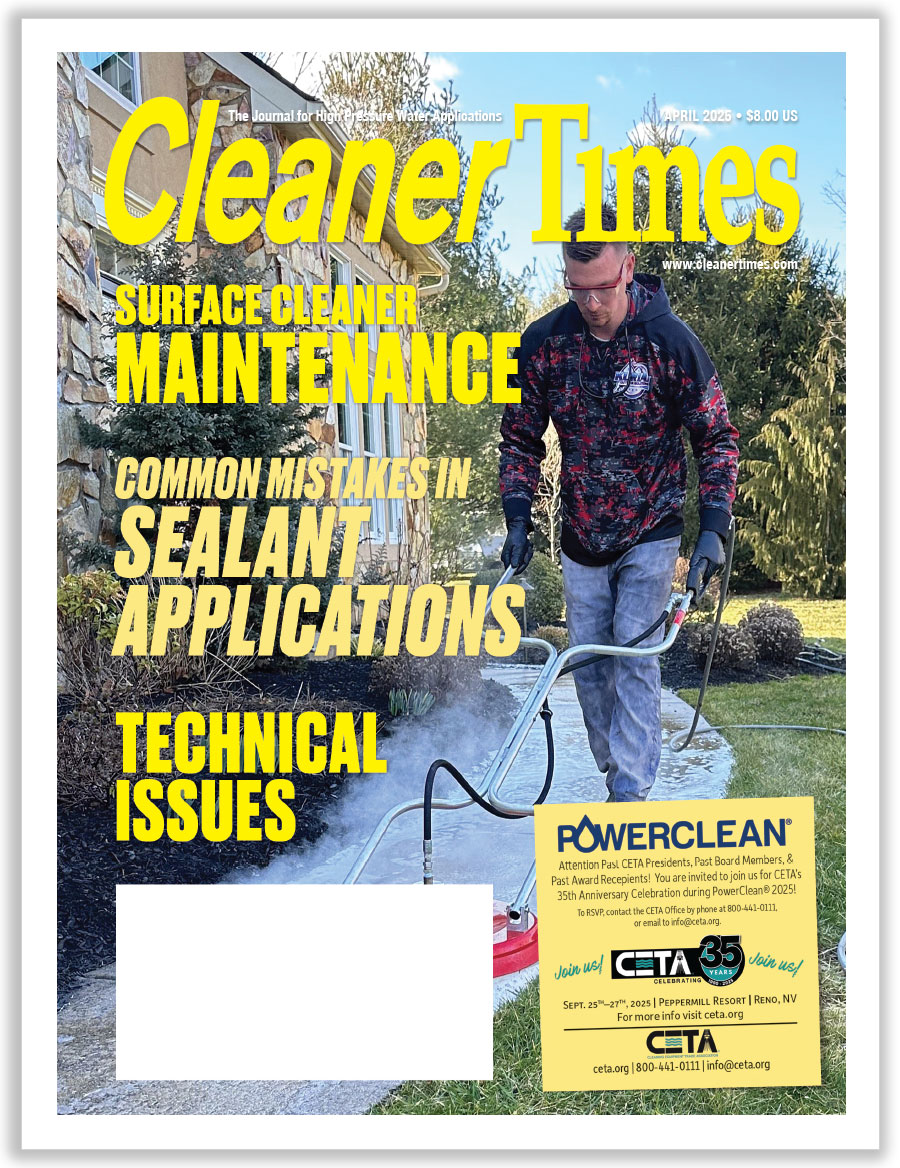
OSHA
Sometimes We Need a “Big Brother”
By Kathy Danforth / Published August 2018

Safety is an issue that most folks will agree is important, but a general desire for no one to get hurt may not be enough to inspire companies to be proactive in product design, testing, labeling, and proper use. That is where OSHA (and other government agencies) step in: setting standards, tracking problems, and bringing the weight of law to bear on employers who fail to protect their employees.
“OSHA doesn’t spell out specific requirements for pressure washers,” says Brad Van Otterloo with Mi-T-M Corporation of Peosta, IA. “They just specify the proper environment for the workplace and protective gear. OSHA will not check a pressure washer unless there has been an accident.” Also, even though the federal guidelines must be met throughout the country, some areas may have their own jurisdiction, which may be more restrictive.
“Some states, like Iowa, have their own form of OSHA,” observes Dean Steger, also with Mi-T-M. And for some workplaces, such as mines, ships, or aircraft, other agencies may take the lead—for example, the Mining Safety and Health Association may be the governing safety organization.
Under the Occupational Safety and Health Act of 1970, “employers are responsible for providing a safe and healthful workplace…Employers must comply with all applicable standards. Employers must also comply with the General Duty Clause of the OSH Act, which requires employers to keep their workplace free of serious recognized hazards.”
Employers utilizing pressure washers can demonstrate that they are maintaining a safe workplace by using equipment meeting UL 1776 standards. That certification must be provided by a Nationally Recognized Testing Laboratory (NRTL), such as Intertek, CSA Group, or Underwriters Laboratories (UL). “The majority of the time, we list equipment to both Canadian and U.S. standards,” reports Van Otterloo, “though not every unit has the listing for various reasons. For example, if the machine is used in the oil industry, the machine must be explosion-proof. For these specialized machines we work with our customer to ensure they meet the more stringent requirements necessary for the working environment.” To maintain certification there are ongoing inspections. “We use both CSA and Intertek, and they will check quarterly to ensure we are building products with the same materials to the same standards,” reports Van Otterloo.
The scarcity of injuries caused by equipment failure is a testament to the thoroughness of the UL-1776 standards and quality manufacturing. Van Otterloo describes some of the criteria set for pressure washer safety:
- All pinch points must be covered or protected so a finger cannot get near belts, etc. The lab has a tool to test the accessibility of each area.
- The pump, hose, gun, and other components are pressure tested. If there are pressure relief valves, they are tested to ensure they open at the right values. Based on the specifications, they can change what pressure is tested.
- For equipment with a lifting hook, the hook must be able to hold four times the weight of the unit with all components. This prevents equipment falling on a person or even on a foot if some- one is holding it.
- There are a number of electrical tests. Water cannot enter the enclosure or contact a live component. The grounding and GFCI (ground fault circuit interrupter), if present, will be tested.
- If a unit is above eight hydraulic horsepower or 3200 psi, a longer wand is required. This removes the operator farther from the work area, both to avoid the splash of water, rust, and debris and to prevent a worker from getting his hand in front of the nozzle.
Portable and fixed washers will have different testing based on the temperatures they may be exposed to. “Portable washers may be in lower temperatures, and the material may become brittle due to the cold,” notes Van Otterloo. “A ‘drop test’ is conducted at the specified temperature to ensure the guns will not crack due to the cold if dropped. A stationary unit which is kept inside does not need to withstand the same temperatures and will be labeled accordingly.”
Van Otterloo shares, “I have been working with the standard on the UL-1776 Standards Technical Panel (STP) for more than 12 years, and much has stayed the same; they did a good job when it was written. With the new standard, UL 60335-2-79, there are a few different tests as well as changes in labeling. For example, all ratings need to be in International units of measure. Temperature must be shown in degrees Celsius, pressure in megapascals, [with 1 megapascal—Mpa—equal to approximately 145 psi], and flow in liters/minute, though you can add imperial (U.S.) measurement terms.”
Of course, OSHA oversees workplace safety at every step, including the manufacturing, storing, and shipping that get the product to the end user. Steger advises, “Moving and storage are covered by OSHA standard 1910.178, Powered Industrial Trucks, which covers anyone using a forklift to move materials and equipment. Anyone operating an industrial truck has to be certified and go through training and a driving test to be allowed to operate the machinery.”
At the manufacturing level, Steger states, “OSHA keeps everybody honest; it makes the company provide employees a safe place to work, which is a good thing. One aspect that is constantly changing is training. Any time a process changes, we have to retrain. It keeps us hopping but makes sure we keep workers safe.”
As with the end user, sometimes protection is built in and other times protective equipment is needed. Steger notes, “For example, a time-weighted average of decibel readings over eight hours can be taken. If anyone is exposed to over an average of 85 decibels during this time period, they are required to wear ear protection.”
To ensure safer handling of chemicals, in 2012 OSHA revised standard 1910.1200 to incorporate the UN Globally Harmonized System of Classification and Labeling of Chemicals (GHS). “Now you can go anywhere, and the chemical information will be the same,” explains Steger. “The safety data sheet (SDS) has 16 categories, from hazards and how it was tested to what it was tested on and how it must be shipped. Pictograms have been incorporated, so it is more user friendly. Before, if you had a container, you did not know what it was or the potential dangers without reading the information. With pictograms, you can quickly get an idea of what the hazards are. Employers must train all employees and make them aware of any chemicals they could come in contact with. At our company, new hires have orientation with ‘Employee Right to Know’ on the day they start.”
OSHA inspections are random unless the manufacturing facility has a reportable injury. Steger says, “The criteria for them to do an investigation would be an accident that results in a fatality, amputation, loss of an eye, or hospitalization.” OSHA requires reports of serious injuries or fatalities in the workplace, but according to Steger, “There is no track record where OSHA is coming back to the Standards Technical Panel saying, ‘Make these changes.’ While there are occasional injuries, there is not a pattern of mechanical failure causing accidents. In one case, an end user slipped while holding the trigger and cut his boot and foot. In other cases, end users have tripped over a cord or hose.”
Van Otterloo points out, “In looking through the OSHA database, you do see misuse and mishandling. For example, it is a misuse to use a pressure washer to clean someone off no matter what the pressure. Also, when a hose is used over a concrete edge or sharp corner, this contact may cut the hose, so it develops a leak which can spray and possibly hurt someone. When equipment is checked, it should be checked for frayed hoses as well as frayed electrical cords.”
Pressure washing equipment has been studied and tested over decades; operators and new scenarios are the variables. Steger states, “For safety, the most important points are to get trained and read the instruction manuals.”





